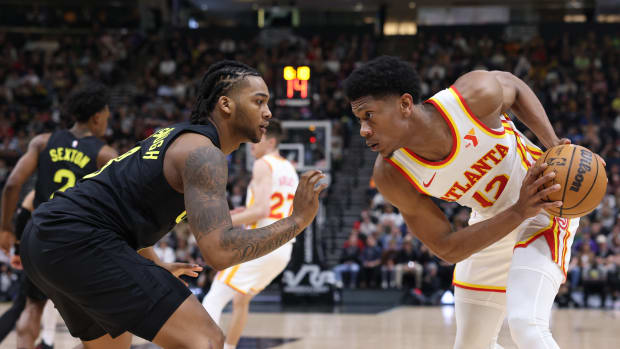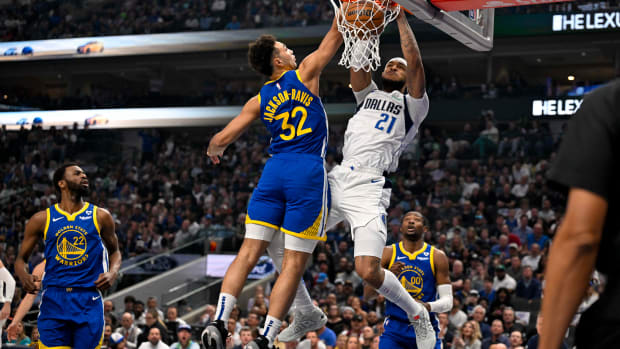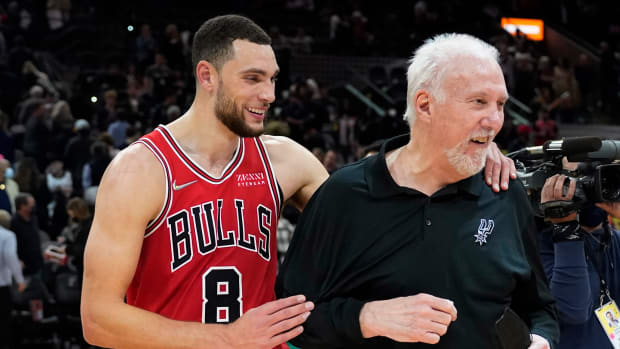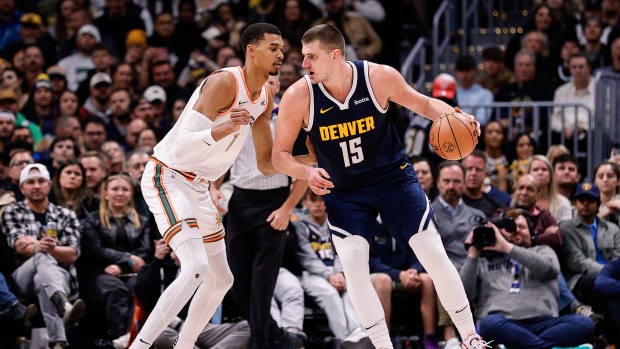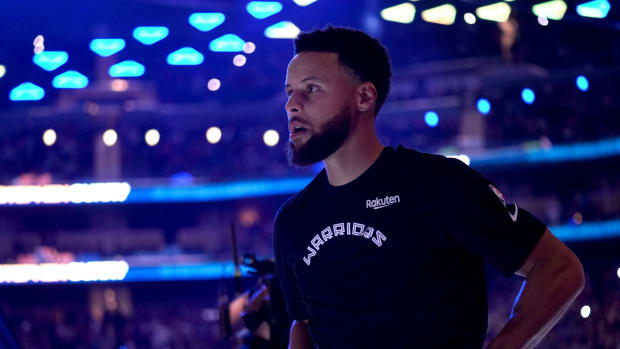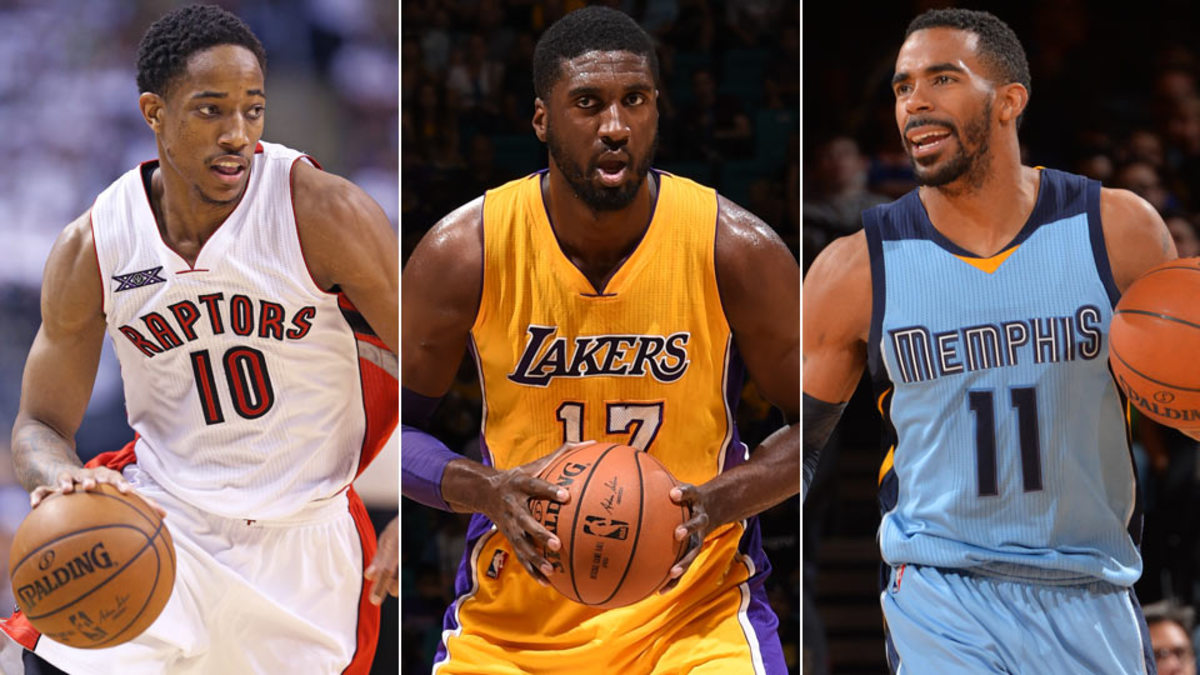
Contract years: NBA players looking to cash in during the 2015-16 season
The start of the NBA’s 2015–16 season is less than two weeks away, which means the race to the gigantic pot of gold that’s waiting in the summer of 2016 is about to begin.
Although LeBron James (yes, again) and Kevin Durant are both on track to be free agents, next summer’s headliner will be the salary cap itself. The NBA’s new nine-year, $24 billion media rights deals will kick in for the 2016–17 season, leading to a gigantic jump in the salary cap. As a reminder, the 2015–16 salary cap is set at $70 million, while the 2016–17 cap projects to be roughly $89 million. That one-year, $19 million jump nearly matches the total increase in cap size the league saw over the last 10 seasons combined (going from $49.5 million in 2005–06 to its current level).
If you’re still warming to the idea that Al-Farouq Aminu might be worth $30 million over four years or that Brandon Knight might represent decent value at $70 million over five years, then shield your eyes. The supply/demand relationship will be really out of whack next summer: While teams will have hundreds and hundreds of millions of dollars in new cap space to fill, there will be precious few star players for the taking.
Here’s the list of 2015 All-Stars who can become free agents next summer: James, Durant, Pau Gasol, Al Horford, Dwyane Wade, Kobe Bryant, Tim Duncan and Dirk Nowitzki. From that group—which swells in number thanks to aging legacy players like Duncan and Wade on short-term deals—there are probably only three targets who might change teams: Durant, Horford and Gasol. All three play for contending-type teams currently, making pitches from outsiders that much more difficult.
• MORE NBA: Best benches | Coaches under pressure | Over/under bets
What happens if they use the same strategy as most of the 2015 free agency headliners and stay put? Second-tier and third-tier talents will get paid somuchmoney. With that inevitable endgame in mind, let’s survey some of the most fascinating contract years that will play out over the next six months. Included with each player is a comparable contract signed this summer.
Note: This post intends to highlight players who can cash in with strong 2015–16 seasons, so presumptive max players (James, Durant, Horford, Dwight Howard, etc.) and legacy stars (Bryant, Wade, Duncan, Nowitzki, etc.) are not included. This post also only includes potential unrestricted free agents.
Ryan Anderson, Pelicans
2015-16 salary: $8.5 million | Last contract: 4-years, $34 million
Although Anderson’s time in New Orleans has been filled with trials and tribulations, as chronicled by SI’s Chris Ballard, the 6’10” stretch four is in position to end his current deal on a high note. One of the NBA’s most voluminous three-point shooting bigs for years, Anderson’s value has waned due to injuries and shooting slumps over the last two seasons. But the arrival of new coach Alvin Gentry and his up-tempo system should help put Anderson into situations where he is playing rather than thinking.
Reinventing the New Orleans Pelicans
New Orleans’s shaky depth and early-season health issues should grant him every opportunity to get back on track. Anderson grades out as a minus defender, but he’s hitting the market in the age of the shooter, so that might not matter all that much if he gets his shot back on track. The Pelicans have their franchise player in Anthony Davis and proved with this summer’s questionable re-signing of Omer Asik that they’re willing to spend to keep talent around Davis.
A convincing bounce-back season could propel Anderson into the same vicinity as Denver’s Danilo Gallinari ($45 million over three years total after two-year extension) and Brooklyn’s Thaddeus Young ($54 million over four years). If, however, he has a third straight down (or incomplete) year, the financial damage will likely be major.
Nicolas Batum, Hornets
2015-16 salary: $11.9 million | Last contract: 4-years, $46 million
Batum finds himself in an unusual situation: he’s on track to hold all the leverage next summer despite the fact that he’s coming off his worst season since his 2008–09 rookie campaign. There are a few reasons for that.
First, the Hornets parted with Noah Vonleh, a promising 2014 lottery pick who is still a teenager, to acquire Batum in a trade with the Blazers this summer. Failing to re-sign Batum next summer, almost regardless of how he plays this season, would amount to a major black eye for a franchise that’s struggled to gain credibility. Second, Batum’s skillset—when things are going well, he can knock down threes, playmake a little for others, and bring defensive versatility on the wing—are all in short supply in Charlotte, especially now that perimeter stopper Michael Kidd-Gilchrist has been lost to injury for six months. Third, the 26-year-old Batum is in the career arc sweet spot: he’s old enough to have accumulated playoff experience and held down a starting role on a high-functioning offense, but he’s still young enough that his next contract won’t take him much past his 30th birthday. Fourth, Hornets owner Michael Jordan is about as impatient as they come, and if his choices are losing Batum or overpaying him, the latter seems more likely.
Back in 2012, Batum found himself in a memorably sloppy restricted free agency saga. Hopefully his 2016 summer will be less dramatic. If the Frenchman can rediscover his shooting stroke and add some zest to a clunky Hornets offense, he could be headed for DeMarre Carroll money ($58 million over four years from Toronto).
Mike Conley, Grizzlies
2015-16 salary: $9.6 million | Last contract: 5-years, $40 million
As Conley enters the final year of his rookie extension, he represents one of the best values in the NBA. That’s been true for the last two years too: While Conley hasn’t gotten over the All-Star hump, he’s a perennial candidate for All-Defensive selections, he’s helped lead the Grizzlies to five straight postseason appearances, and he’s in the conversation when it comes to the league’s top five point guards.
Ranking the NBA's new head coaches: Who is facing the most pressure?
Needless to say, Memphis understands that the good times can’t last forever. After committing big money to Marc Gasol this summer, the Grizzlies must do the same with Conley, 28, or watch their investment go to waste and their title window close. Conley’s earning power is aided by durability, quality personality, and the fact that he’s clearly the marquee name in a weak point guard crop next summer. Memphis’s roster stability sets him up nicely for a big year.
Indeed, Conley is a logical candidate to receive a max-type deal, and he should zoom past Miami’s Goran Dragic ($85 million over five years) into the realm of the highest-paid players at his position.
DeMar DeRozan, Raptors
2015-16 salary: $9.5 million | Last contract: 4-years, $38 million
DeRozan is the early leader in the clubhouse when it comes to projecting the most polarizing contract of 2016 (assuming he opts out of his 2016–17 player option). In an era when 3-and-D wings are getting paid left and right, DeRozan is 3-less and D-less. To make up for his lack of perimeter range and minus defensive contributions, he scores in volume through trial-and-error (16.5 FGA per game last year) and sheer force (6 FTA per game). There are other nits to pick: he’s not a natural playmaker for others, he’s struggled to play efficiently in the postseason, and his lone All-Star selection came in a down year (and in the weaker East).
While DeRozan runs counter to the archetype that got Khris Middleton and Wesley Matthews paid this summer, he’ll still be one of the biggest names at his position next summer. Bryant, Wade and Wizards’ restricted free agent Bradley Beal are all likely to stay put (or in Bryant’s case possibly retire), leaving DeRozan as arguably the best remaining name that has a chance of moving. He is, after all, an athletic 26-year-old wing with traditional size who has averaged 20+ points twice for teams that have enjoyed significant success.
Toronto has a lot of emotional capital invested in DeRozan and no obvious candidates to replace him if he walks. That said, it’s fair to wonder how far the Raptors’ current core of Kyle Lowry, DeRozan, DeMarre Carroll and Jonas Valanciunas can go, and if there’s enough money to keep all four on big-dollar contracts. Whether or not Raptors GM Masai Ujiri is the one to pay up, there’s a strong chance someone pays DeRozan somewhere in the neighborhood of Dallas’s Matthews ($70 million over four years) and Chicago’s Jimmy Butler ($92 million over five years) if he elects to hit the market.
Pau Gasol, Bulls
2015-16 salary: $7.4 million | Last contract: 3-years, $22 million
Gasol and other post-prime contributors are clear winners when it comes to the rising cap. Rewind two years, and the Spanish center essentially had to compromise when it came to finding a new home in free agency, as the teams that could offer him the most money weren’t necessarily the same teams that had the best chance of winning. Gasol wound up choosing wisely, getting a nice payday and the chance to be competitive in Chicago, but his annual salary still represented a massive paycut from his previous deal.
SI.com's Top 100 NBA Players of 2016
It goes without saying that Gasol’s best earning days are in the past now that he’s 35, but the rising cap should offer him the opportunity to claim a raise next summer if he has another nice year for the Bulls. Things look good on paper. A surprise 2015 All-Star, Gasol’s shooting range and passing ability make him an intriguing fit for new coach Fred Hoiberg, even though he has diminished as an interior defender. Chicago fell apart against Cleveland in the playoffs without him, and he stands to play a central role again in 2015–16. Playing in the East helps too.
Despite his advancing age, Gasol should be able to get an Amir Johnson-like deal ($24 million over two years from Boston), or more, if he staves off major decline and decides to opt out next summer.
Eric Gordon, Pelicans
2015-16 salary: $15.5 million | Last contract: 4-years, $58 million
Pelicans fans could be forgiven if they’ve spent the better part of the last three years counting down the days until Gordon was off their books. The 2008 lottery pick has missed significant time in six straight seasons, and he’ll be an interesting test case next summer. Matthews proved that a player coming off a serious injury could still get compensated in a big way. Will Gordon wind up proving that a player with a chronic injury history can still get paid because there’s just so much cash to go around?
As with Anderson, Gordon is a player many teams would covet if he was healthy. Last season, he shot a blistering 44.8% from deep on more than five attempts a game. Even if his defense takes points off the table and even though his to-the-basket game has fallen off a cliff, he’s still theoretically capable of being a complementary floor-spacer. One-trick ponies can still get paid, as long as that trick is hitting three-pointers often enough that defenders can’t ignore you to swarm Davis.
Gordon’s knee problems make it impossible to project his value nine months from now. The Lakers’ Lou Williams ($21 million over three years) might be a realistic early target, given that the 26-year-old Gordon averaged a career-low 13.4 points per game and missed 21 games last year. Should he reverse five straight seasons of decline, even if he just stops the bleeding and displays some level of reliability, someone might be willing to take a chance on him at a higher number.
Jeff Green, Grizzlies
2015-16 salary: $9.2 Million | Last contract: 4-years, $35 million
No one seems to have any idea quite what to do with Green. He wasn’t good enough to stick as a long-term third wheel in Oklahoma City, he wasn’t able to be a building block in Boston, and his fit was hit-or-miss down the stretch last season in Memphis, as he alternated between starting and a reserve role.
Off-season grades: Southwest Division
At 29, Green is unlikely to provide clear and convincing answers to his positional questions, although his uptick in three-point shooting after his trade to the Grizzlies was a good start. This summer, Green picked up his $9.2 million player option, and there’s definitely some significant variability to how much he can expect next summer. He’s ideally cast as a combo forward for a veteran team looking to win—which happens to describe his situation in Memphis—but his mediocre PER and damaging Real Plus-Minus hurt his case for major money. Boston didn’t particularly suffer after trading him, and the onus is on Green to prove he can contribute positively in Memphis’s traditional structure.
If the fit questions persist, Green might need to settle for bench contributor money like Houston’s Corey Brewer ($23 million over three years). In his mind, Green is likely looking at Denver’s Wilson Chandler ($47 million over four years after a three-year extension) as a more optimistic comparison point for his worth. Clearly, there’s a lot of money to be made or lost in this one.
Roy Hibbert, Lakers
2015-16: $15.6 million | Last contract: 4-years, $58 million
Indiana’s decision to move on from Hibbert just three years after giving him a max rookie extension doesn’t mean his days as an earner are over. Far from it. The Lakers are hardly an ideal landing spot for anybody these days, but Hibbert is guaranteed major minutes in L.A. and he seems to be seizing his opportunity by showing up to camp in slimmer shape. If there’s a silver lining to being surrounded by minus defenders, it’s that Hibbert will get all the credit if the Lakers show any discernible improvement on that end.
Even if Hibbert, 28, continues to struggle with his consistency and even if his offensive game continues to be difficult to watch, his size, interior defense and durability keep him in the discussion for another fat contract in 2016. Yes, the 2016 market for centers is pretty stacked—Horford, Gasol, Al Jefferson, Joakim Noah, Nene and Timofey Mozgov will all be unrestricted free agents—but the Lakers lack experienced alternatives at the position.
Comparison points for Hibbert might include New Orleans’s Omer Asik ($58 million over five years) as a baseline and, if things go better than expected this year, New York’s Robin Lopez ($54 million over four years).
Al Jefferson, Hornets
2015-16 salary: $13.8 million | Last contract: 3-years, $41 million
Charlotte is staring down a crossroads with Jefferson, who put together a 21.8/10.8 season in 2013–14 before taking a step back last year due to injuries. Entering his 12th season at age 30, Jefferson remains one of the league’s craftiest low-post scorers, but the Hornets have struggled to build a competent offense around him. The league’s burgeoning obsession with pace-and-space doesn’t bode all that well for full-bodied big men with lower-body health concerns.
Will Michael Kidd-Gilchrist's injury doom the Hornets' playoff hopes?
How the Hornets decide to handle Jefferson’s free agency will say a lot about their big-picture philosophy. GM Rich Cho has assembled a striking number of stretchy bigs, and that may or may not mean a long-term shift to a less rigid approach to positions is coming. For now, it’s best not to prematurely write off Jefferson, given that he’s only one year removed from being one of the league’s most productive centers and that he reportedly dropped significant weight by swearing off fried chicken this summer.
A return to form could net Jefferson something in the range of Brooklyn’s Brook Lopez ($63 million over three years), given their comparable offensive skill level. Jefferson had to smile when he saw the deal signed by Oklahoma City’s Enes Kanter ($70 million over four years), too. Even if Jefferson can’t get back to his 2013–14 levels, Phoenix’s Tyson Chandler ($52 million over four years) looks like a good basement as long as he stays reasonably healthy, given that Chandler is three years his senior.
Brandon Jennings, Pistons
2015-16 salary: $8.3 million | Last contract: 3-years, $24 million
It’s hard to put a positive spin on a season-ending Achilles injury, but at least the summer showed a few promising signs for Jennings. For starters, Matthews’s monster pay after a similar injury, suffered more recently than Jennings's, should give him confidence that the injury shouldn’t be the primary determining factor of his next contract if he can approximate his previous production once healthy this season.
There was also the little matter of Stan Van Gundy’s generous spending spree. Although Jennings conflicts position-wise with Reggie Jackson, Detroit’s $80 million man, he remains one of the roster’s top talents and he showed some positive signs before his injury. It’s a weird question to ask about such a polarizing and flawed point guard, but it still must be asked: Can the Pistons afford to let him walk? Would another losing season make the thought of losing him that much harder to swallow or, conversely, would it hasten his exit?
Jennings, 26, will reportedly start participating in drills shortly, and he should get the chance to make his case on the court to the Pistons and the 29 other teams before decision time next summer. The lack of 2016 point guard depth might help him: if Conley remains with the Grizzlies, Jennings is arguably the best unrestricted point guard on the board. While Jennings might see himself as a peer to Jackson ($80 million over five years) or Phoenix’s Brandon Knight ($70 million over five years), a safer but still ambitious target might be Indiana’s Monta Ellis ($44 million over four years).
Timofey Mozgov, Cavaliers
2015-16 salary: $5 million | Last contract: 3-years, $14 million
One team that can’t wait for the new salary cap to kick in is the Cavaliers. Max deals for LeBron James, Kevin Love and Kyrie Irving have made life very expensive for owner Dan Gilbert and his management team, as they are currently engaged in an extended staredown with Tristan Thompson. Cleveland’s reluctance to take care of Thompson can be attributed to the massive luxury taxes it would need to pay once he’s signed and the knowledge that it must be prepared to offer Mozgov a gigantic salary increase next summer.
What are Tristan Thompson's services worth to the Cleveland Cavaliers?
Between the two players, Mozgov is the more indispensable. He’s a true center at 7’1”, he’s an effective complementary scorer and a valuable interior defender, he had a transformational impact on the Cavaliers following a midseason trade last year, and he’s smack in his prime at 29. If James wants to bring a title to Cleveland, Mozgov needs to be there.
Those circumstances could help Mozgov triple his bargain salary next summer, especially if Cleveland makes another deep run in the playoffs as expected. That would put him in the same ballpark as New York’s Robin Lopez ($54 million over four years) and Phoenix’s Tyson Chandler ($52 million over four years). Thompson was reportedly seeking a max, though, so perhaps Mozgov will feel compelled to take a similar approach and push even harder.
Joakim Noah, Bulls
2015-16 salary: $13.4 million | Last contract: 5-years, $60 million
Timing really is everything in negotiations. Two season ago, in his career year, Joakim Noah was an MVP candidate and All-Star who would have commanded max money on the open market but settled for a modest raise because he was in the middle of a long-term deal. Last year, in his career year, Jimmy Butler was an All-Star who commanded $95 million over five years (raising his salary from $2 million last year to $15.3 million this year) because his contract happened to end at the perfect moment.
Noah, now 30, is unlikely to return to his peak levels. His production plunged due to injuries last season and Hoiberg’s arrival threatens to cut further into his role. When healthy, Noah is one of the most active and effective defenders in the game, and he’s able to make up for his limited scoring ability with an unusual feel for playmaking at his position. The high-energy nature of his game takes a toll on his body, though, and his lack of individual offensive options was exploited badly by Cleveland in last year’s playoffs.
There’s an unquantifiable benefit to Noah’s personality that helped sustain Chicago through Derrick Rose’s many injuries during the Tom Thibodeau era. This season could go a lot of ways. Noah might get marginalized in a frontcourt that seems ready to downsize and spread out. He might prove invaluable if he can stay healthy and Gasol can’t. He might be the only one of Chicago’s bigs who proves capable of defending the rim in the playoffs. He might further deteriorate. That both Gasol and Noah are in contract years only heightens the uncertainty.
The obvious comparison point for Noah is Phoenix’s Tyson Chandler ($52 million over four years). Chandler, like Noah, is a former Defensive Player of the Year who faced questions about his health, but the Suns committed to him anyway after he was able to string together a nice 2014–15 season with the Mavericks. Again, it was all about timing. If Noah has worse luck, his basement is probably Boston’s Amir Johnson ($24 million over two years).
Rajon Rondo, Kings
2015-16 salary: $9.5 million | Last contract: 1-year, $9.5 million
Rondo wasn’t supposed to be on this list. Many assumed he would be entering year one of a lucrative, long-term deal thanks to a resume that includes four All-Star appearances and a championship ring. Obviously, he had a contract year to forget in 2014–15: Boston traded him, Dallas couldn’t make it work, and he bailed out during the playoffs under the guise of a mysterious injury.
Rajon Rondo says he was joking about relationship issues with George Karl
His red flags are obvious: he can’t shoot, he needs the ball, he has a reputation for needing to do it “his way,” he’s slipped from his All-Defensive form, and he hasn’t been the same guy since an ACL injury. Still, Sacramento took a chance on him in hopes that his vision, experience and playmaking could help foster development from DeMarcus Cousins and help them improve in the standings. This was a marriage of convenience—Sacramento had trouble landing free agents and Rondo apparently didn’t generate much interest after his ugly exit in Texas—that allows both sides to move on immediately if it doesn’t work out.
Rondo is still just 29, but life came at him really fast, didn’t it? The good news for him, like Jennings, is that a solid season would put him at or near the top of the list when it comes to the 2016 point guard market. The bad news, though, is that the position is loaded league-wise and there are fewer and fewer teams willing to start a non-shooter at the position. His best bet might very well be to milk more money and more years out of the Kings.
Right now, Rondo’s best comparison point is himself. If he has a good 2015–16 season, he could pull a modest raise and a multi-year deal. If not, his career plunge will continue.
Hassan Whiteside, Heat
2015-16 salary: $981,000 | Last contract: 2-years, $1.7 million
This list saved the best for last. Whiteside, 26, is the NBA’s biggest enigma and his story should be familiar by now. After years of paying his dues in the D-League and globetrotting in foreign countries, Whiteside blew up to the tune of 11.8/10 last year for the Heat. That production—which translates to an astonishing 17.8/15.2 per-36 minutes—put him among the league leaders in a number of advanced metrics, including PER. Given that he was on a minimum contract, the mercurial Whiteside was immediately represented one of the NBA’s best values, even if reports of immaturity started trickling out by the end of the season.
Absolutely everything is in play for both Whiteside and the Heat this season. There aren’t many 7-footers who can match his athleticism and length, and Miami’s lineups set up well to support him. What more can an unproven center ask for than a starting lineup filled with former All-Stars and All-NBA guys (Dragic, Wade, Luol Deng and Chris Bosh) at every position?
Off-season grades: Southeast Division
The scope of Whiteside’s potential outcomes, from a contract perspective, is vast. As the Sun-Sentinel details, Miami is limited a bit in its ability to retain him thanks to various salary cap rules. Long story short: Whiteside will be an unrestricted free agent next summer, and he has the potential to be the most productive center, including Horford, on the market. If he plays to his potential, the Heat’s ceiling rises considerably, as would their interest in keeping him. That means, theoretically, a max-type salary has to be in play.
At the same time, heavy skepticism is warranted. Rarely do players “figure it out” this late in their career, and the start of Whiteside’s season has already been delayed due to a calf strain. Back in March, not that long ago, Wade was publicly ripping Whiteside’s “selfish moments” and questioning his reliability. Is it conceivable that he would revert to bad habits and find himself without an NBA home, again, next year? That would be a major, major disappointment, but Larry Sanders looms as a go-to cautionary tale.
Does Whiteside understand that Oklahoma City’s Enes Kanter, a polarizing center whose (former) teammates questioned his attitude, raked in $70 million over four years this summer? Does he truly get it? That’s one of the biggest and most fascinating questions of the 2015–16 season. This really is the contract year of all contract years.
































